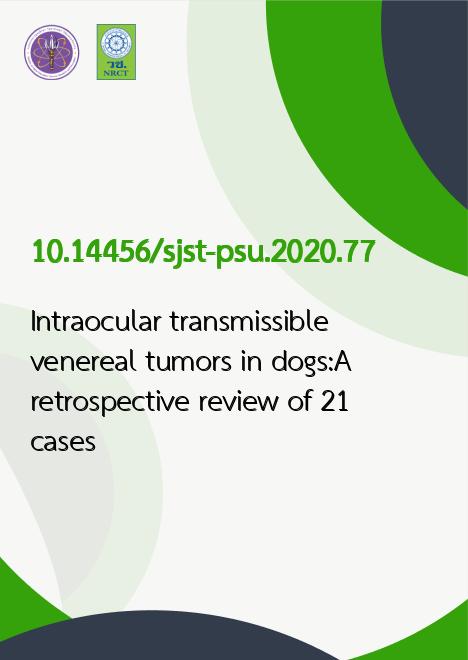
|
Intraocular transmissible venereal tumors in dogs:A retrospective review of 21 cases |
|---|---|
| รหัสดีโอไอ | |
| Creator | 1. Natthanet Sritrakoon 2. Phudit Maneesaay 3. Chaiyan Kasorndorkbua 4. Supreeya Srisampan |
| Title | Intraocular transmissible venereal tumors in dogs:A retrospective review of 21 cases |
| Publisher | Research and Development Office, Prince of Songkla University |
| Publication Year | 2563 |
| Journal Title | Songklanakarin Journal of Science and Technology |
| Journal Vol. | 42 |
| Journal No. | 3 |
| Page no. | 608-614 |
| Keyword | dog, eye, intraocular, transmissible venereal tumor |
| URL Website | https://rdo.psu.ac.th/sjstweb/index.php |
| ISSN | 0125-3395 |
| Abstract | Twenty-nine canine intraocular transmissible venereal tumor (TVT) tissue samples from 21 dogs diagnosed between2008 and 2014 were reviewed retrospectively. The following clinical data were compared: patient signalment; onset of clinicalsigns; ophthalmic signs; location of intraocular lesion; duration of unilateral intraocular TVT to bilateral intraocular TVT duringthe two-year follow-up period; and treatment. Thirty-eight percent (8/21) of the dogs with intraocular TVT eventually hadbilateral intraocular TVT within two years. Seventy-five percent (6/8) of the dogs with bilateral intraocular TVT had initiallypresented with a unilateral lesion. Two dogs that presented with intraocular TVT had no history of genital or extragenital TVT.Chemotherapy did not lead to complete remission of intraocular TVT in contrast to genital and extragenital TVT. Enucleationwas performed for all affected eyes. The spread of genital/extragenital TVT to unilateral or bilateral intraocular TVT should beconsidered and monitored for at least 24 months or longer. |
